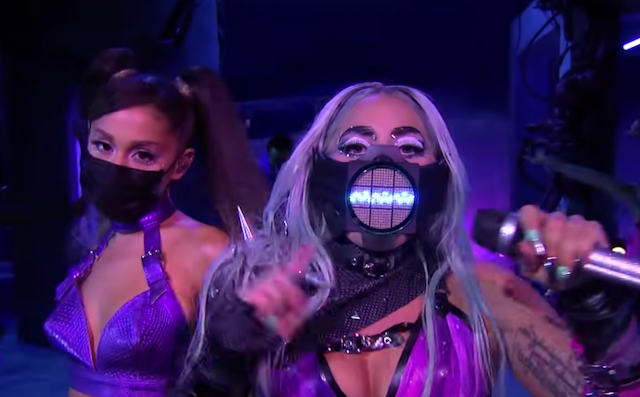Before a bruise-coloured backdrop, Lady Gaga and Ariana Grande performed a medley of Chromatica II and Rain on Me at MTV’s recent Video Music Awards (VMAs). Gyrating in purple and black, the singers’ costumes were distinctive for including face masks.
Gaga’s mouth covering, possibly inspired by the breathing apparatus of Darth Vader or Batman villain Bane, featured an animated wavelength. The mask’s pixelated oscillations seemed appropriately dystopian for a performance that included a piano housed in a puce-coloured, brain-like carapace. By contrast, Grande’s mask appeared to be more of an afterthought, consisting of a small rectangle of elasticated black cloth.
Face coverings on stage may seem obvious, even uninspired, amid a pandemic. Most of the world’s governments have now made mask wearing mandatory in public. And yet, the reason for this costume decision probably wasn’t straightforward.
There is a long global tradition of mask-wearing in live performances, making COVID-19 more of a catalyst than a cause in Gaga and Grande’s clothing choice.
Masked performances on the small screen
Pre-pandemic, and across both sides of the Atlantic, The Masked Singer has challenged television audiences to identify performers of famous songs. The concept, in which artists’ bodies are completely concealed within brightly-coloured and slightly unnerving costumes, was adapted from the South Korean television show, King of Masked Singer, which began in 2015.
This global, cross-cultural fascination with masks in contemporary singing performances, which is to say nothing of their ubiquity on fashion catwalks, offers a more convincing frame for Gaga and Grande’s VMA dress. There’s a paradox to these masked performances: even though an artist’s conventional identity is concealed, they are often more expressive and engaging than performances where artists can be clearly recognised.
It seems appropriate that today’s forms of masked musical performance draw inspiration from Asian models. Some of the oldest traditions of live performance that involve face and head coverings can be traced to China and Japan.
China’s Bian Lian, “face changing”, is a highly skilled, secretive form of acting within Sichuan opera that uses face coverings to guide narrative. Characters’ masks are quickly changed with deft movements of the hand to signal fluctuations in mood.
Similarly, Japanese Noh performances use of over 400 types of wooden face mask to indicate a character’s social position and shifting emotional state. Noh can be translated as “skill”. The term expresses the highly disciplined nature of this deeply expressive medium.

Asian traditions of masked musical performance have gradually become known in the West through routines on America’s Got Talent and Tian-Ming Wu’s film, The King of Masks.
European traditions of masked performance
Continental Europe also has its own costumed customs.
Italy’s Commedia dell’ Arte and its French derivation, the Comédie Française, were essentially improvised skits that combined music, mask wearing and stock characters.
The most popular characters are Harlequin and Pierrot. This masked duo, who were in a never-ending duel for the love of the beautiful Columbine, became widely popular across Europe in the 20th century. Contemporary artists, including Paul Cèzanne and Pablo Picasso, became these characters in self-portraits or used their dress and props to create portraits of family members.

Earlier still, during the 17th century, the royal court masque became popular. An allegorical drama that involved music and choreographed masked dancing, it reached its peak in England under the tense partnership of poet Ben Jonson and architect Inigo Jones. Jonson and Jones used masking and music to support the institution of Stuart monarchy by crafting plots that emphasised the necessity for divinely-sanctioned kingship.
As Europe’s political and cultural authority spread globally, particularly during the 19th century, so too did its traditions of masked musical performance.
Since 1957, to mark its independence of British rule, Ghana has staged the Winneba Fancy Dress Festival, staged each year on January 1 and involving masked dance contests. Amalgamating Ghanaian forms of live performance and the costume traditions of the Dutch and British, artist Hakeem Adam suggests the festival “is a living museum – it reminds us of the past as well as catalysing conversation on the conditions of the present.”
If these examples show that masked singing performances entertain – chiefly because of their skill and surprise – they also explain their ubiquity and deep cultural resonance. Anonymised performers make use of multiple senses – sight, sound, touch – to create a “total artwork” (gesamtkunstwerk) that blurs the divide between reality and recreation. This unique, ambiguous form of performance enables an audience to project their thoughts – individual and collective – onto the artists, who essentially become avatars and act as a psychological salve. They can facilitate the simultaneous exploration of spectators’ hopes and fears – about a global pandemic in the case of Lady Gaga and Arianna Grande – national identity and social roles.
Reflecting on her VMA collaboration with Ariana Grande, Lady Gaga explained:
We create things that make us feel comfortable. We put them all around. I do it all the time. We all do things to make ourselves feel safe. And I always challenge artists when I work with them. I go, ‘Make it unsafe, make it super fucking unsafe and then do it again’.
In identifying the provocation caused by face coverings, Gaga connects – however inadvertently – with a long and global performance tradition that recognises the potential of masks to excite and to explore contemporary social issues.

